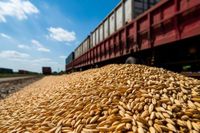From the sunbaked fields of southern Russia to the lush orchards of Azerbaijan, the late summer of 2025 has seen a notable surge in agricultural exports across the Caspian region. Two distinct stories—one of barley from Astrakhan, Russia, and another of hazelnuts from Azerbaijan—are capturing attention for their scale, efficiency, and the meticulous controls underpinning their journeys abroad. These developments, while rooted in local economies, reflect broader trends in regional trade, food safety, and the growing influence of non-oil exports on national economies.
Between August 22 and August 28, 2025, more than 8,800 tons of barley grown in Russia’s Astrakhan region were shipped to Iran through the seaport of Olya, according to reports from local agricultural authorities. This shipment, significant in both volume and destination, was not just a matter of loading grain onto a vessel and waving it off. Instead, it was the product of rigorous oversight by the Rosselkhoznadzor—the Russian Federal Service for Veterinary and Phytosanitary Surveillance—spanning the Rostov, Volgograd, and Astrakhan regions, as well as the Republic of Kalmykia.
Officials were keen to stress the thoroughness of the process. Every step, from the initial harvest to the final loading, was monitored closely. The Astrakhan branch of the Federal State Budgetary Institution “TsOK APK” played a central role, conducting laboratory analyses and issuing electronic veterinary certificates. Transport vehicles underwent disinfection, and their movements were tracked to ensure compliance with health standards. The authorities made it clear that, as stated by the press service, “No violations were found during the inspection.” This was more than a routine declaration; it was a testament to the region’s commitment to delivering safe, high-quality products to international markets.
Why all the fuss? In today’s global food trade, reputation is everything. A single shipment tainted by disease or contamination can have consequences that ripple far beyond a single port or season. That’s why, as representatives of the regulatory agency emphasized, “The control was carried out in full compliance with the standards for the export of safe and high-quality products.” Such assurances are not only about ticking boxes—they’re about maintaining trust with trading partners, in this case, Iran, which relies on Russian barley for its own agricultural and food processing needs.
This episode in Astrakhan is emblematic of a wider movement across the region, where agricultural exports are increasingly seen as engines of economic growth, diversification, and international cooperation. Just south of Russia, Azerbaijan is experiencing its own export boom—though with a different crop and a different market in mind.
According to Trend, citing the August edition of the “Export Review” by the Center for Analysis of Economic Reforms and Communication, Azerbaijan exported forest hazelnuts valued at 82 million US dollars in the first seven months of 2025. That figure represents a dramatic increase—28.5 million dollars, or 53.3 percent—over the same period in the previous year. To put it in perspective, from January to July 2024, Azerbaijan’s hazelnut exports stood at 53.5 million dollars. The leap in 2025 is, by any measure, impressive.
But hazelnuts are just one piece of Azerbaijan’s broader non-oil export puzzle. The country, long known for its energy sector, has been working to diversify its economy and reduce its reliance on oil and gas revenues. The data bears this out: non-oil exports from Azerbaijan in the first seven months of 2025 reached 2.09 billion US dollars, an increase of 11.4 percent compared to the same period in 2024. This shift is not just about numbers—it’s about resilience, sustainability, and the ability to weather global price shocks in the energy markets.
What’s driving this surge in hazelnut exports? Part of the answer lies in the global appetite for healthy snacks and ingredients, with hazelnuts prized for their flavor, nutritional value, and versatility in products ranging from chocolate spreads to bakery goods. Azerbaijan, with its favorable climate and centuries-old traditions of nut cultivation, is well positioned to meet this demand. Investments in modern processing facilities, improved quality control, and marketing have all played a role in boosting both the volume and value of exports.
It’s also worth noting that the export figures reflect not just raw output, but the ability of Azerbaijani producers to meet stringent international standards. Buyers in Europe, the Middle East, and beyond expect products that are not only tasty, but also safe and traceable. The rise in exports suggests that local producers are successfully navigating these demands, opening doors to new markets and higher prices.
Of course, the story doesn’t end at the border. For both Russia and Azerbaijan, the success of agricultural exports is closely tied to the effectiveness of their regulatory systems. In Russia, the Rosselkhoznadzor’s hands-on approach—verifying laboratory results, monitoring transport, and issuing certificates—serves as a model for how to ensure food safety in a complex, cross-border environment. In Azerbaijan, the focus on economic analysis and transparent reporting, as seen in the “Export Review,” helps policymakers and producers alike track progress and identify opportunities for further growth.
These achievements come at a time when global food supply chains are under increasing pressure, whether from climate change, geopolitical tensions, or shifting consumer preferences. The ability of regions like Astrakhan and Azerbaijan to maintain, and even expand, their export operations speaks to a certain resilience. It suggests that, with the right mix of oversight, innovation, and market savvy, agricultural producers can thrive even in uncertain times.
Looking ahead, both regions face challenges as well as opportunities. For Russia’s barley exporters, maintaining rigorous standards will be essential if they want to hold onto and expand their presence in markets like Iran. Any slip in quality or safety could quickly undermine hard-won gains. For Azerbaijan’s hazelnut growers, the challenge lies in sustaining growth, adapting to changing market conditions, and continuing to invest in quality and efficiency.
Yet if recent months are any indication, both are up to the task. The numbers tell a story of ambition, adaptability, and a growing confidence in the region’s ability to compete on the world stage. And for the farmers, processors, and officials behind these exports, there’s a sense that their efforts are finally bearing fruit—sometimes quite literally.
In a world hungry for reliable sources of food and agricultural products, the Caspian region’s latest export successes offer a reminder that, with diligence and vision, even traditional sectors can find new life and new markets.



